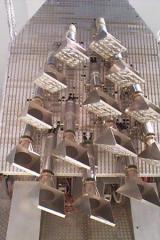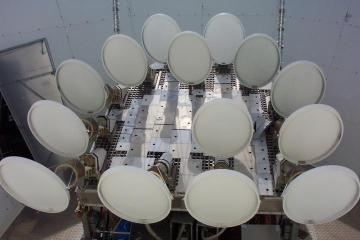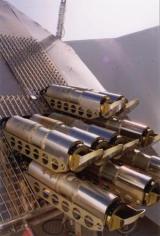The Very Small Array. Brief Description

The Very Small Array (VSA) is a 14-element heterodyne interferometer array, tuneable between 28 and 36 GHz with a 1.5 GHz bandwidth and a system temperature of approximately 30K, sited at 2400 m altitude at the Teide Observatory in Tenerife. Each receiving element consists of a corrugated horn-reflector antenna (CHRA) feeding a cooled HEMT amplifier. The CHRA consists of a conical corrugated horn feeding a section of a paraboloidal mirror at 90o to the paraboloid axis. This arrangement gives a compact antenna with an unblocked aperture, and hence low sidelobes. The mirror can be rotated about the axis of the feedhorn, allowing tracking in one dimension. The receivers are mounted on a tilting table hinged along its northern edge, providing tracking in a second dimension. In order to achieve close packing of the antenna apertures, the receivers are mounted at an angle of 35o to the table; the elevation range of the table of 0o-70o thus gives a range of zenith angle of 35o in the north-south direction, with the rotating mirrors providing approximately +/- 45o in the other axis. The array is surrounded by an aluminium ground screen to limit interference and groundspill; the internal sides are sloped to direct rays from the table into the sky. For a more detailed description, see Watson el al. (2003).
The VSA antennas
The VSA has been designed with three different set of antennas. The first one, was designed for use in a compact array, for observations up to a maximum multipole of l = 900, which corresponds to a maximum separation of antennas of ~1 m. These antennas have illuminated apertures of 143 mm diameter, giving a primary beam of 4.6o FWHM at 34 GHz. The second set of antennas was designed for observations at higher l, modified by increasing the length of the horn and fitting a larger mirror, giving an aperture of 322 mm and a primary beam of 2o FWHM. The aim of this extended array is to maintain the sensitivity of the instrument when the antennas are separated, by keeping approximately the same filling factor. The extended array has a minimum baseline of 0.5 m, and a maximum of 2 m, covering the multipole range between l = 400 and l = 1600. The VSA started its observations with the first set of antennas, but from October 2001 until 2005, the instrument was measuring with the extended configuration.
Since January 2006, the VSA is measuring using the Super-Extended Configuration. The new antennas have illuminated apertures of 608 mm diameter, giving a primary beam of 1.0o FWHM at 33 GHz, and with and angular resolution of 6 arcminutes. This set of antennas has been designed to observe in the high-multipole tail of the CMB angular power spectrum.
 |
 |
Very Small Array Specifications
Main array:
| Compact Array | Extended Array | Super-Extended | |
| Primary beam (deg) | 4.6 | 2.0 | 1.0 |
| Resolution (arcmin) | 30 | 11 | 6 |
| Multipole range | 100-900 | 250-1500 | 500-2500 |
| Sensitivity (mJy in 300hrs) | 30 | 6 | 2 |
Source Substraction system:
| Type | 2-element, 3.7m dishes |
| Baseline | 9 m, separation N-S |
| Primary beam (arcmin) | 12 |
| Resolution (arcmin) | 3 |
| Sensitivity | 5mJy in 1 hour |
